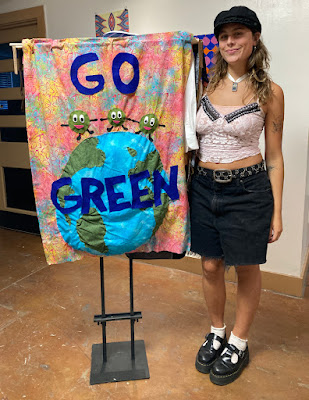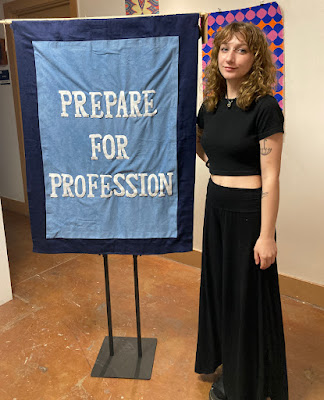Textiles at Flagler College
Thursday, 13 February 2025
Wednesday, 12 February 2025
MAKE INK FROM NATURAL DYE
To make ink using natural dye powder, mix chosen dye powder with a liquid medium like water, and add a binding agent like gum arabic to help the pigment adhere and create a smooth ink consistency; you can adjust the amount of dye powder to achieve the desired color intensity, and strain the mixture to remove any particles before using it as ink. Once cooled, add wintergreen essential oil to preserve.
Thursday, 19 December 2024
Diversity Banner Project 2024
Tuesday, 15 October 2024
Shauna Gentile, Student Work
Ode to Intention Featuring Sydney
Top - Salvaged paint poured flat and crocheted with second hand yarn.
Skirt - Salvaged denim, second hand yarn used to create a crochet inlay pattern which was then backed with hand dyed textile.
Belt and Scarf - Hand dyed with logwood with soda ash, overlaid with Indigo pattern and embroidered.
Ode to Intention Featuring Brooke
Top - Yarn hand dyed with cochineal, crochet.
Skirt - Salvaged paint, crochet with hand dyed cochineal yarn.
Ode to Intention
I designed, prepared the textiles, constructed the garments and photographed this body of work. Inspired by sustainable textile practices, I used second hand materials such as salvaged denim and paint to create "one-of-a-kind" textiles. I created this collection to highlight discarded materials in the realm of fashion. My sustainable designs seek to challenge the conventional notions of modern fast fashion.
Student Blogs, Spring 2026
Clare Cassidy Rhys Conner Gem Hansen Hayley Harris Julia Hewitt Sophia Johnston Laurel Koschal Owen Lindsey Colin Locatell Alaina Medina E...
-
Summary Unbound book of folded paper leaves containing a range of sewing and knitting samples, produced by Anne Trotter in 1840 at the Femal...
-
Clare Cassidy Rhys Conner Gem Hansen Hayley Harris Julia Hewitt Sophia Johnston Laurel Koschal Owen Lindsey Colin Locatell Alaina Medina E...






















































